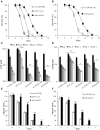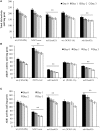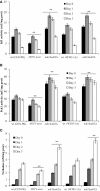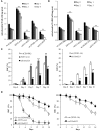Altered Expression of Mitochondrial NAD+ Carriers Influences Yeast Chronological Lifespan by Modulating Cytosolic and Mitochondrial Metabolism
- PMID: 30619489
- PMCID: PMC6305841
- DOI: 10.3389/fgene.2018.00676
Altered Expression of Mitochondrial NAD+ Carriers Influences Yeast Chronological Lifespan by Modulating Cytosolic and Mitochondrial Metabolism
Abstract
Nicotinamide adenine dinucleotide (NAD+) represents an essential cofactor in sustaining cellular bioenergetics and maintaining cellular fitness, and has emerged as a therapeutic target to counteract aging and age-related diseases. Besides NAD+ involvement in multiple redox reactions, it is also required as co-substrate for the activity of Sirtuins, a family of evolutionary conserved NAD+-dependent deacetylases that regulate both metabolism and aging. The founding member of this family is Sir2 of Saccharomyces cerevisiae, a well-established model system for studying aging of post-mitotic mammalian cells. In this context, it refers to chronological aging, in which the chronological lifespan (CLS) is measured. In this paper, we investigated the effects of changes in the cellular content of NAD+ on CLS by altering the expression of mitochondrial NAD+ carriers, namely Ndt1 and Ndt2. We found that the deletion or overexpression of these carriers alters the intracellular levels of NAD+ with opposite outcomes on CLS. In particular, lack of both carriers decreases NAD+ content and extends CLS, whereas NDT1 overexpression increases NAD+ content and reduces CLS. This correlates with opposite cytosolic and mitochondrial metabolic assets shown by the two types of mutants. In the former, an increase in the efficiency of oxidative phosphorylation is observed together with an enhancement of a pro-longevity anabolic metabolism toward gluconeogenesis and trehalose storage. On the contrary, NDT1 overexpression brings about on the one hand, a decrease in the respiratory efficiency generating harmful superoxide anions, and on the other, a decrease in gluconeogenesis and trehalose stores: all this is reflected into a time-dependent loss of mitochondrial functionality during chronological aging.
Keywords: NAD+; Ndt1; Ndt2; Saccharomyces cerevisiae; chronological lifespan.
Figures






Similar articles
-
Nicotinamide, Nicotinamide Riboside and Nicotinic Acid-Emerging Roles in Replicative and Chronological Aging in Yeast.Biomolecules. 2020 Apr 15;10(4):604. doi: 10.3390/biom10040604. Biomolecules. 2020. PMID: 32326437 Free PMC article. Review.
-
During yeast chronological aging resveratrol supplementation results in a short-lived phenotype Sir2-dependent.Redox Biol. 2017 Aug;12:745-754. doi: 10.1016/j.redox.2017.04.015. Epub 2017 Apr 9. Redox Biol. 2017. PMID: 28412652 Free PMC article.
-
Nicotinamide supplementation phenocopies SIR2 inactivation by modulating carbon metabolism and respiration during yeast chronological aging.Mech Ageing Dev. 2017 Jan;161(Pt B):277-287. doi: 10.1016/j.mad.2016.06.006. Epub 2016 Jun 16. Mech Ageing Dev. 2017. PMID: 27320176
-
Sir2 and Glycerol Underlie the Pro-Longevity Effect of Quercetin during Yeast Chronological Aging.Int J Mol Sci. 2023 Jul 31;24(15):12223. doi: 10.3390/ijms241512223. Int J Mol Sci. 2023. PMID: 37569599 Free PMC article.
-
The role of NAD and NAD precursors on longevity and lifespan modulation in the budding yeast, Saccharomyces cerevisiae.Biogerontology. 2022 Apr;23(2):169-199. doi: 10.1007/s10522-022-09958-x. Epub 2022 Mar 9. Biogerontology. 2022. PMID: 35260986 Free PMC article. Review.
Cited by
-
Nicotinamide, Nicotinamide Riboside and Nicotinic Acid-Emerging Roles in Replicative and Chronological Aging in Yeast.Biomolecules. 2020 Apr 15;10(4):604. doi: 10.3390/biom10040604. Biomolecules. 2020. PMID: 32326437 Free PMC article. Review.
-
Glucosinolates from Seed-Press Cake of Camelina sativa (L.) Crantz Extend Yeast Chronological Lifespan by Modulating Carbon Metabolism and Respiration.Antioxidants (Basel). 2025 Jan 11;14(1):80. doi: 10.3390/antiox14010080. Antioxidants (Basel). 2025. PMID: 39857414 Free PMC article.
-
Cytoplasmic and Mitochondrial NADPH-Coupled Redox Systems in the Regulation of Aging.Nutrients. 2019 Feb 27;11(3):504. doi: 10.3390/nu11030504. Nutrients. 2019. PMID: 30818813 Free PMC article. Review.
-
Perturbations in mitochondrial metabolism associated with defective cardiolipin biosynthesis: An in-organello real-time NMR study.bioRxiv [Preprint]. 2024 Jun 22:2024.06.18.599628. doi: 10.1101/2024.06.18.599628. bioRxiv. 2024. Update in: J Biol Chem. 2024 Oct;300(10):107746. doi: 10.1016/j.jbc.2024.107746. PMID: 38948727 Free PMC article. Updated. Preprint.
-
SLC25A51 decouples the mitochondrial NAD+/NADH ratio to control proliferation of AML cells.Cell Metab. 2024 Apr 2;36(4):808-821.e6. doi: 10.1016/j.cmet.2024.01.013. Epub 2024 Feb 14. Cell Metab. 2024. PMID: 38354740 Free PMC article.
References
-
- Agrimi G., Brambilla L., Frascotti G., Pisano I., Porro D., Vai M., et al. . (2011). Deletion or overexpression of mitochondrial NAD+ carriers in Saccharomyces cerevisiae alters cellular NAD and ATP contents and affects mitochondrial metabolism and the rate of glycolysis. Appl. Environ. Microbiol. 77, 2239–2246. 10.1128/AEM.01703-10 - DOI - PMC - PubMed
LinkOut - more resources
Full Text Sources
Molecular Biology Databases

